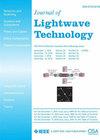1.6 Tbps FOWLP-Based Silicon Photonic Engine for Co-Packaged Optics
IF 4.1
1区 工程技术
Q2 ENGINEERING, ELECTRICAL & ELECTRONIC
引用次数: 0
Abstract
Co-packaged optics (CPO) has emerged as a promising solution to address the limitations of traditional pluggable optical transceivers, offering enhanced bandwidth, improved energy efficiency, and reduced signal loss. This paper presents a low-cost, volume-manufacturable Fan-Out Wafer Level Packaging (FOWLP) silicon photonic engine with an aggregate data transmission capacity of 1.79 Tbps (8 × 224 Gbps). The FOWLP platform enables the seamless integration of Electronic ICs (EICs) and Photonic ICs (PICs) without wire bonds, preserving signal integrity and minimizing losses. By demonstrating 112 Gbaud NRZ (112 Gbps/λ) and PAM4 (224 Gbps/λ) transmission with minimal digital signal processing, this work highlights the potential of silicon photonics for 200 Gbps/λ Co-Packaged Optics (CPO) and Linear Pluggable Optics (LPO) applications. The findings underscore the enhanced signal integrity, power efficiency, and reduced latency achieved with FOWLP, addressing critical bottlenecks in hyperscale data centers and AI/ML clusters.求助全文
约1分钟内获得全文
求助全文
来源期刊

Journal of Lightwave Technology
工程技术-工程:电子与电气
CiteScore
9.40
自引率
14.90%
发文量
936
审稿时长
3.9 months
期刊介绍:
The Journal of Lightwave Technology is comprised of original contributions, both regular papers and letters, covering work in all aspects of optical guided-wave science, technology, and engineering. Manuscripts are solicited which report original theoretical and/or experimental results which advance the technological base of guided-wave technology. Tutorial and review papers are by invitation only. Topics of interest include the following: fiber and cable technologies, active and passive guided-wave componentry (light sources, detectors, repeaters, switches, fiber sensors, etc.); integrated optics and optoelectronics; and systems, subsystems, new applications and unique field trials. System oriented manuscripts should be concerned with systems which perform a function not previously available, out-perform previously established systems, or represent enhancements in the state of the art in general.
 求助内容:
求助内容: 应助结果提醒方式:
应助结果提醒方式:


